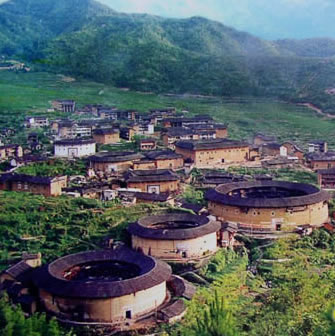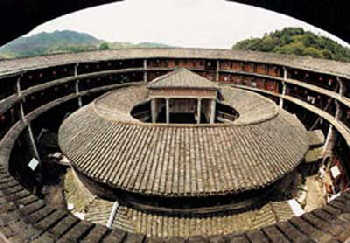

Lingnan Hakka Group houses are a kind of large residence popular among the people called "Hakkas" in Lingnan (places south of the Five Ridges) including Fujian, Guangdong, southern Jiangxi provinces and eastern Guangxi Zhuang Autonomous Region.
In Chinese history, there were two large-scale movements of theHan nationality, from the central plain and then south China. one was in the Western Jin and Eastern Jin period, and the other was in the Northern Song and Southern Song era. -l-his was due to the chaos caused by war in the north, which forced distinguished and big families to undertake a southward shift by the whole clan. They continuously advanced southward, settling in Lingnan areas south of the Five Ridges, which were then still quite backward. The clan lived in compact communities which formed themselves into Hakkas.
Hakkas abided by the cultural tradition before their southward movement. They particularly follow the Confucian rites, worship ancestors, treasure clan unity, value their homeland and were patriotic and paid attention to geomancy, to form a special Hakka Culture. Hakkas group houses are the most characteristic expressions of Hakka Culture. In most cases, they embody the original look of the Han Culture in the central plains during the Jin and Tang dynasties.
For example, Hakka group houses can be regarded as closely related to "Wu Bi" (castle wall) popular during the period from the Eastern Han to the Wei and Jin dynasties.
The term "Wu" (fortified castle) originally referred to a small castle for stationing troops in a frontier fortress. Beginning from the middle part of the EasternHan Dynasty, due to the chaos caused by frequent wars in the central plains, which continued for several hundred years, rich and powerful people vied to build fortified castles for self-defense. For a while, the construction of castles was all the vogue, and those constructed at this time were called Hakka Group Houses. They are in a variety of forms, but mainly fall into two kinds -wu feng lou (five phoenix tower) and tu lou (earthen tower), in addition to wei long Wu (adragon-encircled house). The common characteristics are large size, compact encirclement and a centripetal and symmetrical layout, housing a dozen to several dozen families of the same clan.
Wu Feng Lou consists of the lower hall, middle hall and main hall, called the three halls, arranged from the front to the back along the axial line of the whole residence. The lower hall is the vestibule, while the middle one is the big hall for clan get-together, and both are single storied. The main hall mostly consists of from three to five stories.

Copyright ©1999-2011 Chinanews.com. All rights reserved.
Reproduction in whole or in part without permission is prohibited.